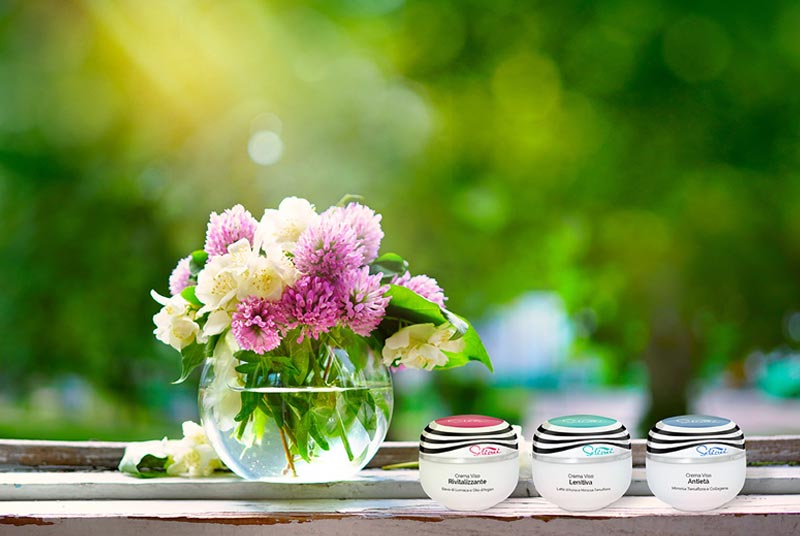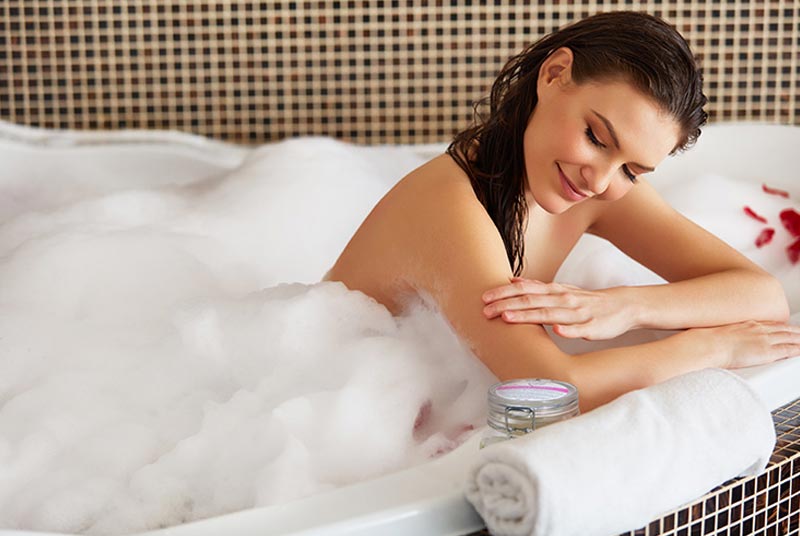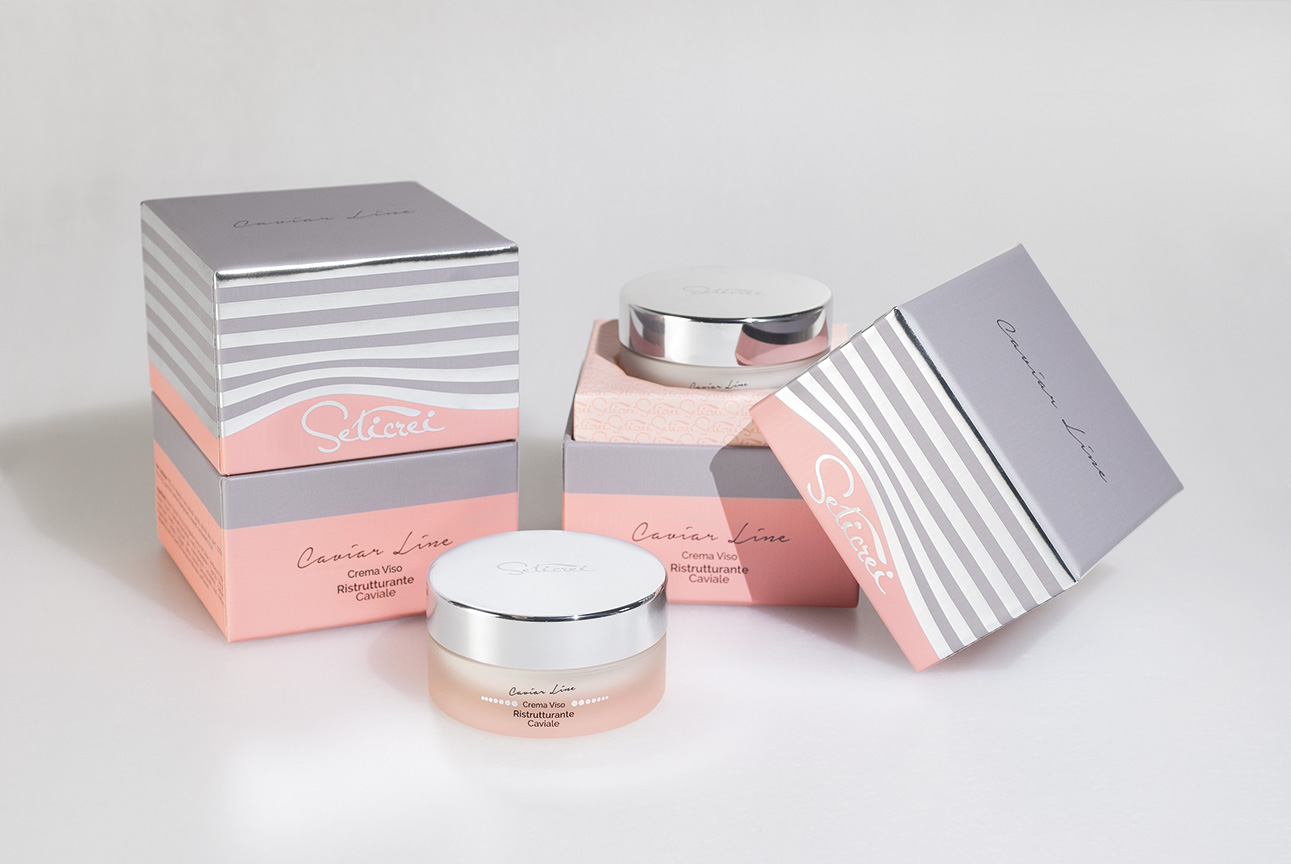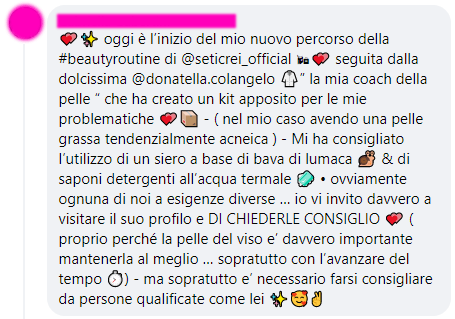Face cream with caviar and silk, 50ml
Functions
A delicate and rich emulsion, thanks to its formula based on very pure Caviar in synergy with precious extracts of peptides, Silk proteins, Cyclodextrins, Vitamin B5, Vitamin E and other fine skin-friendly components. It has an anti-ageing, skin-repairing, elasticizing, replumping and illuminating action.
Directions for use
Ingredients
Check out the ingredients in English
- Aqua: Water.
- Caprylic/Capric Triglycerides: Vegetable oil derived from coconut.
- Glyceryl Stearate SE: Self-emulsifying glyceryl monostearate. A stabilizing agent of great value characterized by the coexistence of an aqueous part and an oily part. It is obtained from the esterification of glycerol with stearic acid (extracted from cocoa and shea plants), therefore composed of polyvalent self-emulsifying bases resulting from derivatives of vegetable origin and rigorously free of peg. It does not introduce electrostatic activity to keep the coalescence between water and oil phases. The ingredient is qualified as safe by the COSMETIC INGREDIENT REVIER (CIR) EXPERT PANEL, as it possesses emollient characteristics of its own.
- Glycerin: Plant glycerol. From ancient Greek, it means “gentle” and is a fat of natural origin with a very emollient and soothing nature, protecting the skin and mucus. Thanks to its slightly antiseptic properties which make it an excellent natural preservative, it is recommended to fight chapped and irritated skin.
- Prunus Amygdalus Dulcis Oil Caviar: (Liposoluble extract of caviar) Extracted from the well-known sturgeon roe, it is an innovative cosmetic ingredients with outstanding ultra-moisturizing, restructuring and anti-free radical actions, and extraordinary anti-ageing properties with revitalizing effects, similar to a facelift. Its composition, rich in nourishing substances and essential fatty acids of high quality (e.g. omega-3), amino acids (glycine, histidine, asparagine etc.) and proteins with a cellular structure very similar to that of human skin, make it a highly skin-friendly beauty ingredient. Another invaluable substance is vitelline, a mixture of phospholipids and phosphoproteins, essential elements for the skin’s cells as it offers the correct stimulation and regeneration of the cellular metabolism. Important constituent molecules are also: threonine (it takes part in the synthesis of elastin and collagen), leucine (it helps the process of healing wounds), lysine (it helps the synthesis of collagen and cellular repair and contributes to the metabolism of fatty acids and arginine (it boosts the synthesis of collagen and as a consequence the tissue trophism). Lastly, it ensures a considerably supply of vitamins fundamental for the skin (A, D, B1, B2 and B6) and mineral trace elements (Co, Cu, P, Si, Zn).
- Cetyl Alcohol: Extracted from palms or coconut plants, it is a high-quality emulsifier used as an emollient.
- Cocos Nucifera Oil: Coconut oil.
- Camelia Sinensis Leaf Extract: (Glyceric extract of Green Tea). Originally from the regions between India, China and Assam, but now frown in many tropical countries, Camelia Sinensis is a shrub that is in wild state is up to 15m. high but which when cultivated, due to continuous pruning, does not exceed a height of one metre and a half. Germinated, according to the story by Lao-Tse, by the eyelids of Durma, the third son of an important Indian king, it was apparently Duchess Anne of Bedford who started the custom in England of drinking tea at five in the afternoon, a drink imported to Europe from China in the 17th century by the Dutch and which then spread rapidly, despite the mistrusting welcome from the medical world. In cosmetics, a significant percentage of tannins (8-26%) gives tea astringent properties while its content in caffeine and theine make it an important lipolytic agent as well as a stimulant and skin energizer; thanks to its content of polyphenolic derivatives, alkaloids, methylxanthin, theobromine and theophylline in small quantities, adenine and xanthan in traces, Vitamin C, fluoride, proteins, dextrins, essential oil, lipids, mineral salts and flavonoids. Lastly, it is an antioxidant and anti-free radical active ingredient.
- Cera Alba: (Yellow beeswax): a secretion from the Italian Apis mellifera, its composition can vary according to region and season of activity of the precious insects; a skin protection factor, it contains from 50% to 56% of unsaponifiables; solid at ambient temperature, but semi-viscous at body temperature, it is used in cosmetics also to regulate and stabilize their consistency.
- Borago Officinalis Seed Oil: (Borage Oil) a perennial herbaceous plant belonging to the family of the Boraginaceae, originally from the Mediterranean area where it still grows wild. It is cultivated in all the temperate regions of the globe (in Italy it is found everywhere from the plains to an altitude of about 1000 m.) with beautiful blue-violet star-shaped flowers. Its name is believed to come from the Latin “borra” (a rough woollen fabric) due to the hairs that cover the leaves. The oil is extracted by cold pressing the seeds. It is without alkaloids and is characterized by a very high content of polyunsaturated fatty acids: linoleic (32-38%), gamma-linolenic (22%-25%), oleic (14%-23%), palmitic (11%), stearic (5%) and alphalinolenic; thanks also to a significant supply of mucilage, flavonoids and prostaglandins, in cosmetics it represents a fundamental emollient, decongesting , antiphlogistic and regulating ingredient of the cellular regenerating processes. It helps maintain the natural degree of moisture and elasticity of the skin, fighting the phenomena of transdermal evaporation. Lastly, it is used in the formulation of softening products against dermatitis, irritation and scaling of the skin (and more in general against dermatological pathologies with an allergic component) as well as an effective restorative and anti-ageing ingredient.
- Prunus Armeniaca Kernel Oil Palmitic/Stearic Triglyceride: PRUNUS ARMENIACA KERNEL OIL PALMITIC/STEARIC TRIGLYCERIDE
- Macadamia Ternifolia Seed Oil: (Macadamia Oil) obtained by cold pressing Macadamia Ternifolia Müller nuts, an evergreen tree of the family of the Protaceae, originally from the south-eastern forests of Australia but today grown also on Hawaii, in Mexico and in some African regions, it appears as a light amber coloured liquid, with low acidity, a neutral aroma and a pleasant and delicate flavour. It glides excellently over the skin and is not greasy to the touch. Used for both food and cosmetics, it is mainly made up of acids: oleic, palmitoleic (essential monounsaturated fatty acid, present in sebum and responsible for the lipid metabolism), linoleic and linolenic, with interesting eudermal properties and a fundamental balancing action on the secretion of fats of the skin considering its resemblance with its acidic content; used in moisturizing cosmetics for dry skins, in anti-ageing formulas, in sun creams and massage oils, it is particularly recommended for the treatment of dull, tired, sensitive or reactive skins, as well as for the formulation of emulsions and oleolytes with an emollient-restorative action; thanks to its sebum-like properties, it is also used in products for the care and treatment of the hair and scalp as, contributing to balancing the lipid secretion of the hair fibre, restoring its correct degree of moisture and fighting dehydration, it leaves hair glossier, softer and silkier..
- Acetyl Octapeptide-3 Caprylyl Glycol: (Snap-8 ®) An innovative and revolutionary peptide which is the result of the in-depth knowledge acquired by modern cosmetics on the mechanisms at the basis of the anti-wrinkle action and a molecule designed specifically to fight lines of expression produced by the contraction of the facial muscles, in particular in the areas of the forehead and eye contour, reducing their extension and depth, it is an effective alternative to the botulin toxin, but is absolutely safe, gentle and without any collateral effect: it has multiple and very interesting cosmetic functions: its myo-relaxing action reduced wrinkles and lines of expression by reducing micro-tensions and micro-contractions of the skin and the cohesion of the cells of the dermis, moisturized in depth increasing the quality and quantity of prostaglandins and glycosaminoglycans naturally present. By encouraging the production of integrins and fighting free radicals, it acts in support of the physiological processes of cellular renewal and, lastly, has significant filmforming properties which induce an immediate surface tensor action, smoothing out the microgrooves of the skin and even making them disappear for a few hours.
- Dipeptide Diaminobutyroyl Benzylamide Diacetate: It is a tripeptide (a three-amino acid- peptide) with a molecular weight below 500 da, which means that it is small enough to easily penetrate the skin.
- Hydrolyzed Silk: (Silk Proteins) From the chemical and conformational point of view, silk is part of the group of protein biopolymers with a fibrous structure; it has two protein constituents; seric fibroin and sericin; the composition of fibroin is qualified by the prevalent presence of glycin (45%) and alanine (30%), amino acids with fundamental emollient and soothing properties, protective of the skin and mucus; sericin, the main protein, has, on the other hand, an outstanding velvetizing and moisturizing character and gives the skin particular softness and leaves it delicately silky to the touch, making the texture finer, smoother, more radiant and more even. Thanks to the low molecular weight the silk proteins can penetrate into the deep levels of the dermis, where their outstanding hygroscopic properties can prevent dehydration as best as possible, keeping the skin smooth and moisturized for a long period of time.
- Hydroxypropyl Cyclodextrin: (Phytodermina Lifting ®) a natural concentrated solution of hydroxypropylbeta-cyclodextrins, cyclic oligosaccharides of starch. It offers all the specific properties of the cyclic sugar molecules, i.e. an accentuated filmforming and tensor effect and outstanding clinically tested moisturizing and revitalizing actions. Its application, recommended for all skin types, immediately induces a definite and prolonged lifting effect and is therefore ideal in elective anti-ageing. both preventive and intensive shock, treatments.
- Sodium Hyaluronate: (Hyaluronic acid) A transparent substance that fills, together with other molecules such as elastin and collagen, the spaces between the fibres of the skin’s tissues and has the prerogative of physiologically slowing down the evaporation and loss of moisture. It is present in abundance in the youngest organisms whilst it decreases with the passing of the years (at 50, for example, only half of the original genetic capital is left); it is precisely for this reason that its molecule is used very successfully in cosmetics and in aesthetic surgery: supplemented transdermally through specific cosmetics, or even injected subcutaneously through micro-infiltrations, it tends to attract and keep the cellular fluids and mix with the hyaluronic acid of the dermis, restoring its initial firmness.
- Benzyl Alcohol Dehydroacetic Acid: A preservative highly tolerated by the skin.
- Panthenol: Panthenol. Vitamin B5 (pantothenic acid) is one of the most interesting vitamins in cosmetic use: it is not applied as it is but as provitamin or panthenol, mainly in the active form (D) and its transformation into vitamin takes place only after local application; pantothenic acid is very important for the human organism as it is one of the main constituents of coenzyme-A, an essential factor for the main vital reactions to take place, including the fundamental cellular regeneration; Vitamin B5 has a triple beneficial action on the skin: it is moisturizing, re-epithelizing (it stimulates the growth of new skin cells) and has considerable anti-inflammatory properties; at the biochemical level, it intensifies the synthesis of lipids and fosters the proliferation of the skin’s fibroblasts; it is characterized by very high moisturizing capacities, great tolerability and protects the skin from redness, chapping and small lesions.
- Thioctic Acid: Alpha-Lipoic acid. Also known as thioctic acid and sometimes shown as Vitamin N, it is a coenzyme which plays a leading role in the natural cellular metabolic processes of animals and plants; synthesized biochemically, it is in the form of a yellow crystalline powder, soluble both in organic solvents and (although to a lesser extent) in water; it is considered as an anti-free radical and excellent universal anti-inflammatory, as it has an antioxidant capacity that is 400 times greater than that of Vitamin E. It can regenerate, boost and prolong the action of this and other antioxidants such as Vitamins A and C, coenzyme Q and glutathione and is the only antioxidant that is active both in an aqueous phase (cytoplasmatic) and lipid one (of the cellular membranes), therefore protecting the organism both from intracellular free radicals and from those outside the cell; a scavenger molecule on lipid and protein catabolites, (it therefore fights both the oxidation of fats and proteins) and protective of collagen and cellular lipids. In cosmetology it is used in the treatment of slackening and weakness of the epidermis, skin ageing and wrinkles (including following damage from exposure to UV rays, whether of the sun or artificial). It is also an effective astringent, sebum-regulating and dermoplastic ingredient against the excessive production of sebum, open pores and scars caused by acne as well as, lastly, an extraordinary soothing, dereddening, antiphlogistic and dynamizing action on the peripheral microcirculation against dark circles, bruises, redness and couperose.
- Cyamopsis Tetragonoloba Gum: Extracted from the seeds of Cyamopsis tetragonoloba, a leguminous plant which has been grown in India and Pakistan for centuries. It is a soluble polysaccharide with exceptional moisturizing and regenerating properties..
- Tocopherol: (Vitamin E) A hydrosoluble form of Vitamin E (tocopherol). It is characterized by extraordinary antioxidant properties that can block the cascade of events which cause oxidative stress and reduce the formation and reactivity of the free radicals, the cause of the well-known damage to cells and at the basis of the ageing processes; characterized by an excellent affinity with the skin, it is far more stable that the vitamin in a free form, more hydrosoluble and, as a consequence, more suitable for being included in a cosmetic formulation; it protects from the action of UV rays and thanks to its contribution in limiting the loss of moisture from the epidermis and maintaining the skin’s moisture, it keeps skin smooth, soft, toned and elastic; for its antioxidant value, it is included in many cosmetics of a higher quality not only as a skin-protective agent, but also as a natural preservative of the other components in the formula.
- Parfum: It is not simply a fragrance of higher cosmetic quality, but it is certified by the manufacturer as hypoallergenic and without GMO or their derivatives.
- Helianthus Annuus Seed Oil Rosmarinus Officinalis Leaf Extract: Rosemary extract. It has great skin-purifying, astringent and antimicrobial properties. It also has sebum control qualities.
Seticrei: 100% natural cosmetic products.
What makes them so unique in the world?

100% natural ingredients

100% pure active principles

100% Dermocompatible





















